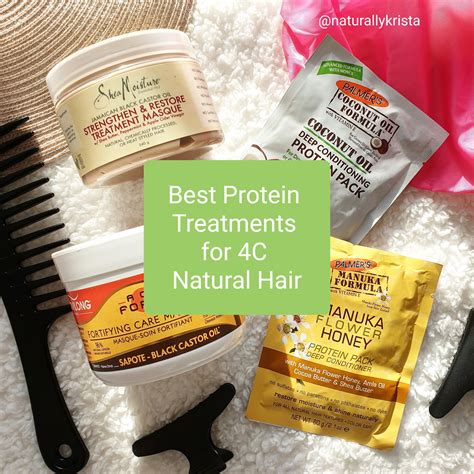Think your hair is beyond repair? Protein treatments can work wonders to restore damaged hair. Here are 5 treatments you can try.

What is a protein treatment?
A protein treatment is a type of hair care treatment that helps to repair and strengthen damaged hair. Proteins are essential for healthy hair, providing structure and strength. When hair is damaged, the proteins in the hair shaft can become broken down, leading to weak, brittle hair. Protein treatments work by filling in these broken proteins, helping to restore hair’s strength and elasticity.
Who can benefit from a protein treatment?
Protein treatments are beneficial for anyone with damaged hair. This includes people with:
- Chemically treated hair
- Heat-styled hair
- Sun-damaged hair
- Bleached hair
- Dry, brittle hair
How often should you get a protein treatment?
The frequency of protein treatments will vary depending on the condition of your hair. If your hair is severely damaged, you may need to get a treatment every few weeks. However, if your hair is only mildly damaged, you may only need a treatment once a month or even less often.
What are the different types of protein treatments?
There are several different types of protein treatments available. Some of the most popular types include:
- Keratin treatments: Keratin is a type of protein that is found naturally in hair. Keratin treatments work by coating the hair shaft with keratin, which helps to smooth and strengthen the hair.
- Collagen treatments: Collagen is another type of protein that is found naturally in hair. Collagen treatments work by adding collagen to the hair shaft, which helps to improve hair’s elasticity and strength.
- Amino acid treatments: Amino acids are the building blocks of proteins. Amino acid treatments work by providing the hair with the amino acids it needs to repair itself.
- Soy protein treatments: Soy protein is a type of plant-based protein that is rich in amino acids. Soy protein treatments work by strengthening the hair shaft and improving hair’s elasticity.
- Egg protein treatments: Egg protein is a type of animal-based protein that is rich in amino acids. Egg protein treatments work by nourishing and strengthening the hair.
How do you apply a protein treatment?
Protein treatments can be applied at home or in a salon. If you are applying a protein treatment at home, follow the instructions on the product packaging. In general, you will need to:
- Wash your hair with a clarifying shampoo.
- Apply the protein treatment to your hair.
- Leave the treatment on for the amount of time specified on the product packaging.
- Rinse your hair thoroughly.
- Style your hair as usual.
What are the benefits of a protein treatment?
Protein treatments can provide a number of benefits for your hair, including:
- Strengthening hair
- Improving hair’s elasticity
- Smoothing hair
- Reducing frizz
- Adding shine
- Protecting hair from damage
Are there any risks associated with protein treatments?
Protein treatments are generally safe for most people. However, there are a few risks that you should be aware of:
- Overuse of protein treatments can lead to dry, brittle hair. If you use protein treatments too often, your hair may become dry and brittle. This is because protein treatments can strip your hair of its natural oils.
- Protein treatments can cause allergic reactions. Some people may be allergic to the ingredients in protein treatments. If you experience any itching, redness, or swelling after using a protein treatment, discontinue use and consult a doctor.
How to choose the right protein treatment for you
The best protein treatment for you will depend on the condition of your hair. If you have severely damaged hair, you may need a stronger treatment than someone with only mildly damaged hair. You should also consider your hair type and texture when choosing a protein treatment. For example, if you have fine hair, you may want to use a lighter treatment than someone with thick hair.
Here are some tips for choosing the right protein treatment for you:
- Read the product reviews. See what other people have said about the product before you buy it.
- Talk to your hairstylist. Your hairstylist can help you choose the right protein treatment for your hair type and needs.
- Start with a mild treatment. If you are new to protein treatments, start with a mild treatment and gradually increase the strength of the treatment as needed.
Protein treatments can be a great way to improve the health and appearance of your hair. By following these tips, you can choose the right protein treatment for your hair and achieve the results you want.
